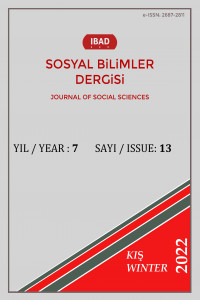Öz
Bu makalede, modern insanın geçmişle hiçbir şekilde bağlantı kuramaması nedeniyle, gerçeklik eksikliğinin karışık ve kopuk bir tarih anlayışına atfedildiği gösterilmektedir. Bu nedenle, yüzey seviyesinde mevcut bir durum, köksüzlük uçurumunu doldurma eğilimindedir. Herhangi bir çeşitlemeye yer olmayan böyle bir evrendeki her postmodern birey, sonunda milyonlarca insanla aynı ama tek başına kalır. Bu nedenle, modern dünyanın sıradan ve ilginç olmayan durumu, sonunda, her şeyin gerçek dışarının sözde çölünden daha büyüleyici ve daha az kuru göründüğü hipergerçeklik dünyasına yol açar. Bu çalışma bağlamında postmodern insanın hipergerçekliğin görünen yapaylığından bıktığı ve ya gerçeği yeniden keşfetmeye çalıştığı ya da gerçeğin yokluğunun ardından kalan anlamsız boş araziyle yüzleştiği ileri sürülmektedir.
Bu nedenle, bu çalışmanın uygulanması, hipergerçeklik, simülasyon ve simülakrın postmodern birey üzerindeki kapsamının ve etkisinin ve bunun nasıl yönetilebilir olabileceğinin anlaşılmasın açısından önemlidir. Özetle, bu makale John Fowles’un Büyücü adlı romanının Jean Baudrillard’ın hipergerçeklik, simülasyon ve simülakr fikrini nasıl uyguladığını incelemeyi amaçlamaktadır. Makaledeki roman incelemesinin bir diğer amacı da, Baudrillard’ın modern evrenin çoğunluğunu oluşturduğunu iddia ettiği hiç bitmeyen simülasyonlardan kurtulma şansının hala olduğunu göstermektir.
Anahtar Kelimeler
Kaynakça
- Akbar, A. (2004). Postmodernism and Islam. Routledge.
- Baudrillard, J. (1990). Seduction. (B. Singer, Trans.) Montréal: New World Perspectives.
- -------------------- (1994). Simulacra and Simulation. (S. F. Glaser, Trans.) University of Michigan Press.
- -------------------- (2000). The Vital Illusion. (J. Witwer, Ed.) New York: Columbia University Press.
- Bauman, Z. (2003). The World According to Jean Baudrillard. In Intimations of Postmodernity (p151-154). Routledge.
- Beville, M. (2009). Gothic-postmodernism: Voicing the Terrors of Postmodernity. Edited by D’haen, Theo, and Hans Bertens. Rodopi.
- Deleuze, G. (1990). The Logic of Sense. New York: Columbia University Press.
- Fowles, J. (1979). The Magus: a revised version. New York: Dell Pub. Co.
- Hussey, B. L. (1983). John Fowles’s The Magus: The Book and the World. The International Fiction Review, 10, No. 1. Retrieved from https://journals.lib.unb.ca/index.php/IFR/article/view/13592
- Olshen, Barry N. (1976). John Fowles’s The Magus: An Allegory of Self‐Realization. Journal of Popular Culture 9, no. 4: 916-24.
- Plato. (1920). The Republic. New York: Burt.
- Raffat, D. (2014). Hedonism: A Novel. Xlibris.
- Salami, M. (1992). John Fowles’s Fiction and the Poetics of Postmodernism. Fairleigh Dickinson University Press.
- Sim, S. (2011). The Routledge Companion to Postmodernism. Routledge.
- Tarbox, K. (1988). The Magus. In The Art of John Fowles. Athens: University of Georgia Press.
- Woolley, B. (1993). Simulation. In Virtual Worlds: A Journey in Hype and Hyperreality. London: Penguin.
Öz
In this article, it is demonstrated that the lack of reality is attributed to a confused and disjointed understanding of historicity since the modern person is unable to connect in any way to the past. Therefore, a surface-level and copycat present tend to fill the chasm of rootlessness. Every postmodern individual in such a universe, where there is no room for any type of variation, ends up being identical to the millions of others, but alone. Therefore, the ordinary and uninteresting state of the modern world eventually gives rise to the world of hyperreality, where everything appears to be more fascinating and less dry than the alleged desert of the real outside. In the context of this study, it is asserted that the postmodern person tires of the apparent artificiality of hyperreality and either strives to re-discover the real or confronts the meaningless wasteland left in the wake of the real’s absence.
Therefore, the application of this study is valuable in demonstrating an understanding of the scope and impact of hyperreality, simulation, and simulacra on the postmodern individual and how it may be manageable. In a nutshell, this article aims to look into how John Fowles’s The Magus applied Jean Baudrillard’s idea of hyperreality, simulation, and simulacra. Another goal of the article’s examination of the novel is to demonstrate that there is still a chance to break out from the never-ending simulations that Baudrillard claims make up the majority of the modern universe.
Anahtar Kelimeler
Kaynakça
- Akbar, A. (2004). Postmodernism and Islam. Routledge.
- Baudrillard, J. (1990). Seduction. (B. Singer, Trans.) Montréal: New World Perspectives.
- -------------------- (1994). Simulacra and Simulation. (S. F. Glaser, Trans.) University of Michigan Press.
- -------------------- (2000). The Vital Illusion. (J. Witwer, Ed.) New York: Columbia University Press.
- Bauman, Z. (2003). The World According to Jean Baudrillard. In Intimations of Postmodernity (p151-154). Routledge.
- Beville, M. (2009). Gothic-postmodernism: Voicing the Terrors of Postmodernity. Edited by D’haen, Theo, and Hans Bertens. Rodopi.
- Deleuze, G. (1990). The Logic of Sense. New York: Columbia University Press.
- Fowles, J. (1979). The Magus: a revised version. New York: Dell Pub. Co.
- Hussey, B. L. (1983). John Fowles’s The Magus: The Book and the World. The International Fiction Review, 10, No. 1. Retrieved from https://journals.lib.unb.ca/index.php/IFR/article/view/13592
- Olshen, Barry N. (1976). John Fowles’s The Magus: An Allegory of Self‐Realization. Journal of Popular Culture 9, no. 4: 916-24.
- Plato. (1920). The Republic. New York: Burt.
- Raffat, D. (2014). Hedonism: A Novel. Xlibris.
- Salami, M. (1992). John Fowles’s Fiction and the Poetics of Postmodernism. Fairleigh Dickinson University Press.
- Sim, S. (2011). The Routledge Companion to Postmodernism. Routledge.
- Tarbox, K. (1988). The Magus. In The Art of John Fowles. Athens: University of Georgia Press.
- Woolley, B. (1993). Simulation. In Virtual Worlds: A Journey in Hype and Hyperreality. London: Penguin.
Ayrıntılar
| Birincil Dil | İngilizce |
|---|---|
| Bölüm | Araştırma Makaleleri |
| Yazarlar | |
| Erken Görünüm Tarihi | 30 Kasım 2022 |
| Yayımlanma Tarihi | 31 Aralık 2022 |
| Kabul Tarihi | 5 Eylül 2022 |
| Yayımlandığı Sayı | Yıl 2022 Sayı: 13 |
IBAD Sosyal Bilimler Dergisi / IBAD Journal of Social Sciences


